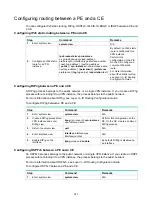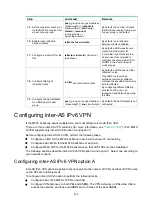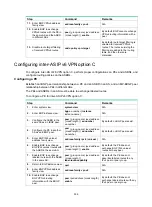
337
Step Command
Remarks
11.
(Optional.) Configure the PE
to not change the next hop of
routes advertised to the peer.
peer
{
group-name
|
ipv4-address
[
mask-length
] }
next-hop-invariable
By default, the device uses its
address as the next hop of routes
advertised to peers.
Configure this command on the
RR so the RR does not change
the next hop of advertised VPNv6
routes.
Configuring an ASBR
In the inter-AS IPv6 VPN option C solution, an inter-AS LSP is needed, and the routes advertised
between the PEs and ASBRs must carry MPLS label information. The configuration is the same as
that in the Inter-AS IPv4 VPN option C solution. For more information, see "
Configuring the routing policy
A routing policy on an ASBR performs the following operations:
•
Assigns MPLS labels to routes received from the PEs in the same AS before advertising them
to the peer ASBR.
•
Assigns new MPLS labels to the labeled routes to be advertised to the PEs in the same AS.
The configuration is the same as that in the Inter-AS IPv4 VPN option C solution. For more
information, see "
."
Configuring multirole host
To configure the multirole host feature for IPv6 networks, perform the following tasks on the PE
connected to the CE in the site where the multirole host resides:
•
Configure and apply IPv6 PBR.
•
Configure IPv6 static routes.
Configuring and applying IPv6 PBR
Step Command Remarks
1.
Enter system view.
system-view
N/A
2.
Create an IPv6 policy
node and enter IPv6
policy node view.
ipv6 policy-based-route
policy-name
{
deny
|
permit
}
node
node-number
By default, no IPv6 policy nodes
exist.
3.
Configure match criteria
for the node.
See
Layer 3—IP Routing
Configuration Guide
.
By default, no match criterion is
configured. All packets match the
criteria for the node.
This step matches packets from the
multirole host.
















































